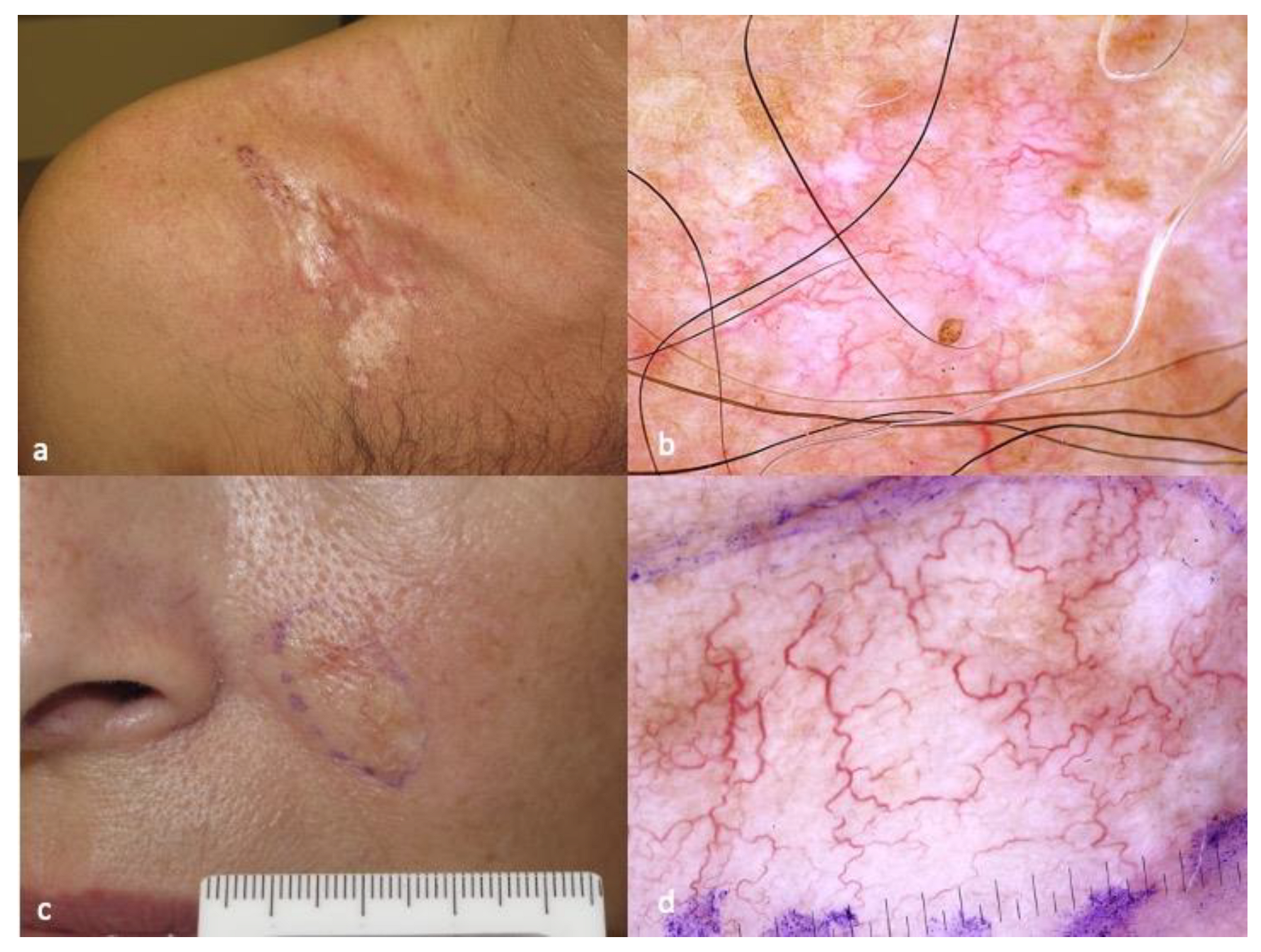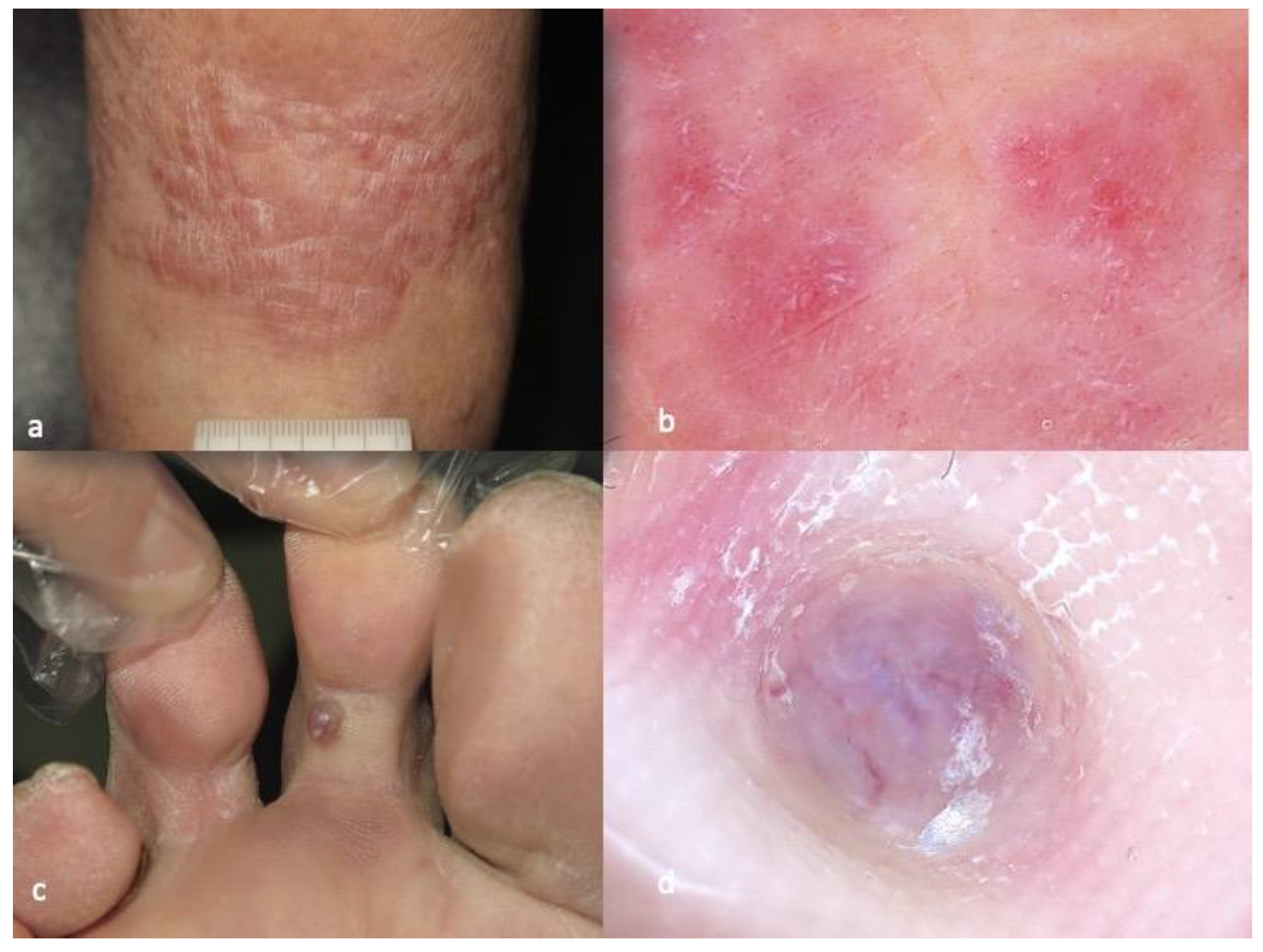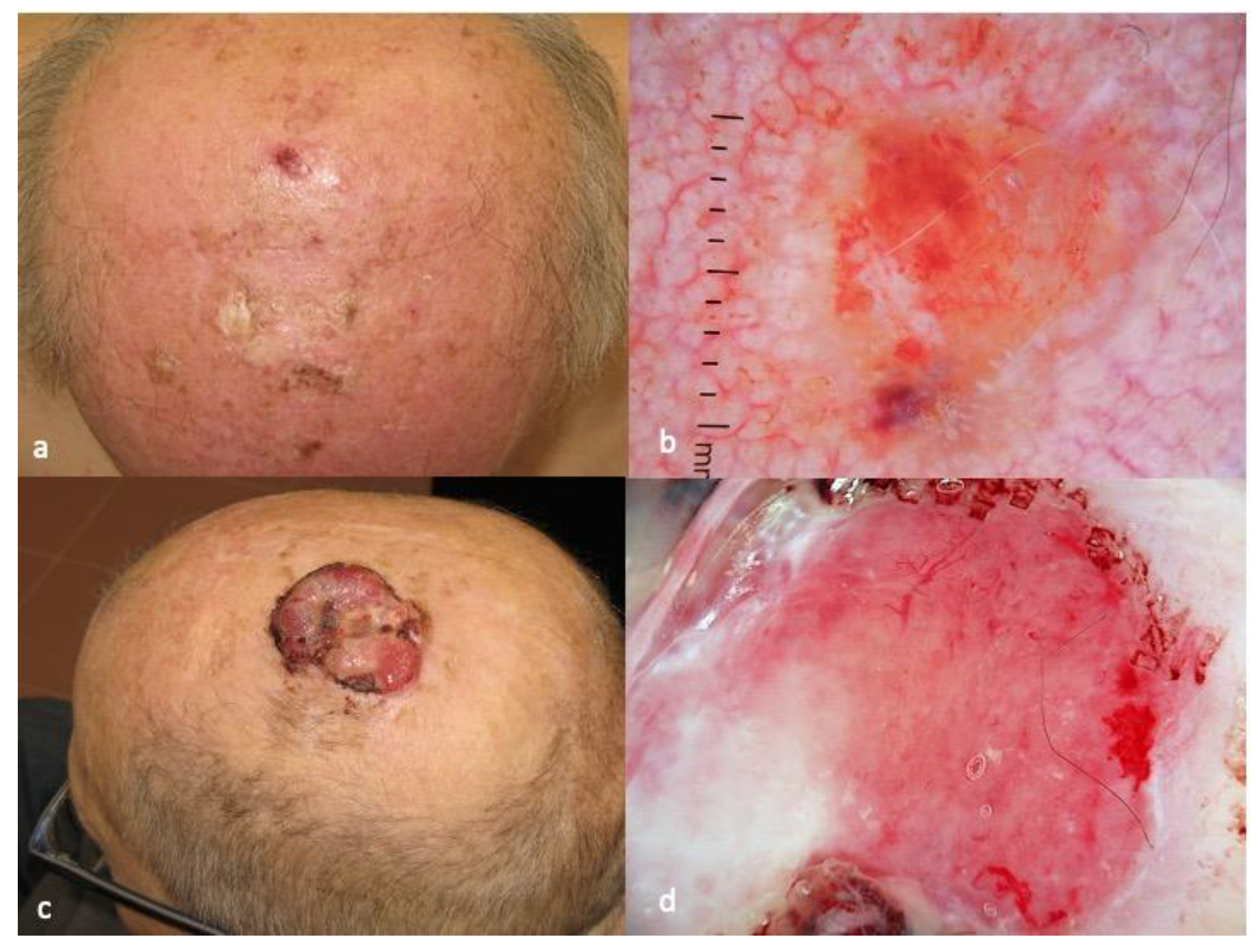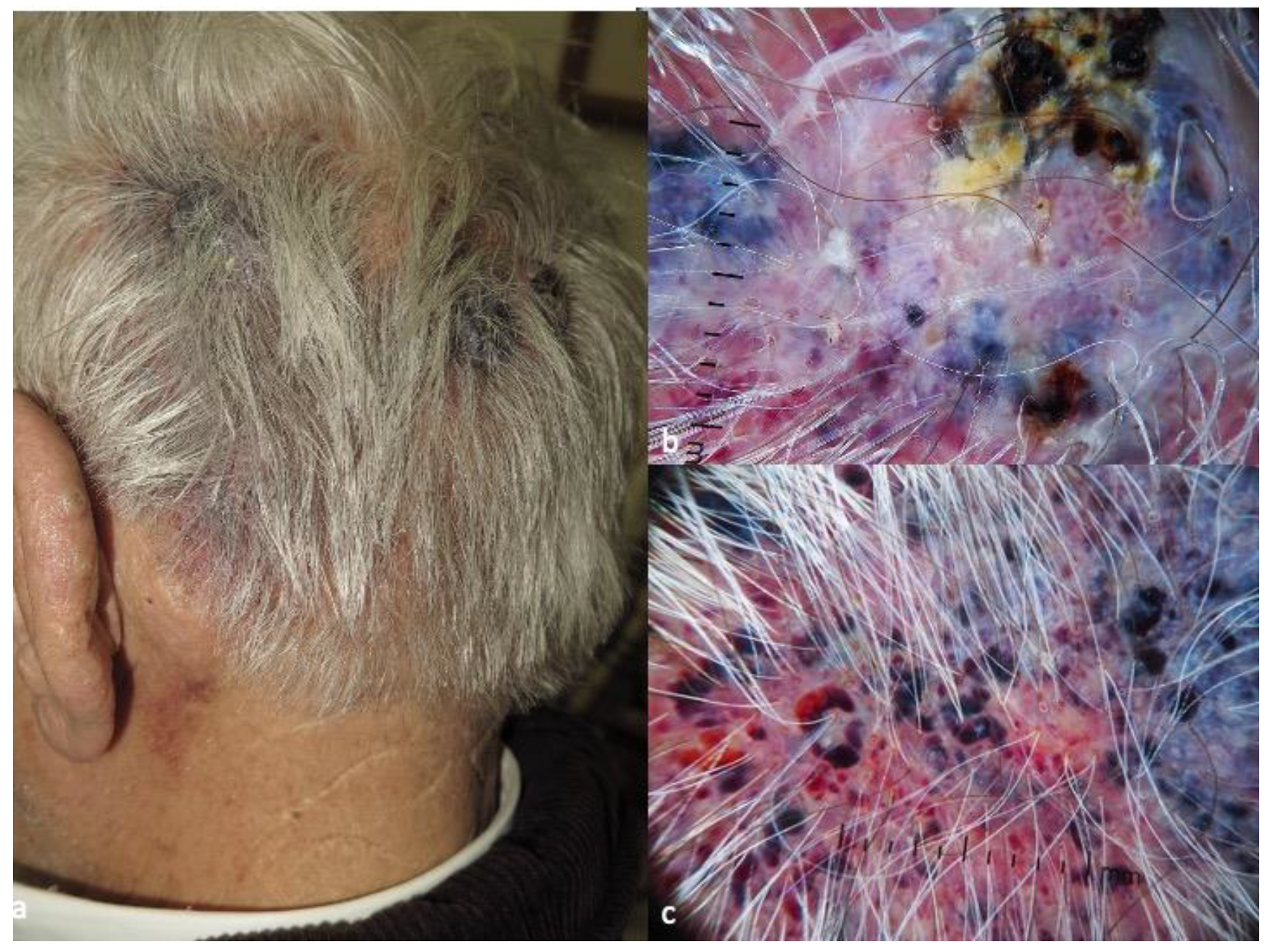Under the umbrella of cutaneous sarcomas (CS), a heterogeneous group of rare, malignant, mesenchymal neoplasia, such as dermatofibrosarcoma protuberans, atypical fibroxanthoma, cutaneous undifferentiated pleomorphic sarcoma, cutaneous angiosarcoma and leiomyosarcoma is included. Clinical presentation and histopathological examination are the cornerstone of CS diagnosis and classification. CS are characterized by mostly unspecific dermatoscopic patterns. Dermatofibrosarcoma protuberans, Kaposi’s sarcoma, and in a lesser degree, cutaneous angiosarcoma, may display distinct dermatoscopic features, facilitating their early clinical recognition. In conclusion, dermatoscopy, in conjunction with the overall clinical context, may aid towards suspicion of CS.
- dermoscopy
- cutaneous sarcoma
- atypical fibroxanthoma
- angiosarcoma
1. Introduction
32. Dermatofibrosarcoma Protuberans (DFSP)
DFSP is considered the most common type of CS. Its rough estimated incidence ranges from 0.8 to 5 cases per million inhabitants, per year. It affects both males and females, with a peak incidence between the second and fifth decade of life. Sites of predilection are the trunk and extremities, but it may ostensibly involve any area of skin [6,7,8,9,10][5][6][7][8][9]. DFSP clinically presents as a firm, exophytic plaque with coalescent, brown-red or flesh-colored nodules on its surface. At the initial stage of evolution, DFSP may present as an atrophic, flat plaque, mimicking a scar or scleroderma. Indolent slow growth, often extending for many years is the rule. During childhood, the predominant clinical morphology is that of a flat or slightly elevated lesion, closely mimicking the plaque-type scleroderma. The size of a DFSP lesion is highly variable, depending on time from disease onset, and usually ranges from 2 to 5 cm in largest diameter. Gigantic lesions measuring up to 20 cm have also been reported. Due to the aforementioned characteristics, delayed diagnosis of DFSP is not uncommon [6,7,8,9,10][5][6][7][8][9]. The dermoscopic pattern of DFSP has been described in case series and case reports, and a fully developed plaque most often consists of a pink-colored background, structureless depigmented areas, structureless light brown areas and vessels that are mostly linear and arborizing (Figure 1) [11,12,13,14,15,16,17,18,19,20][10][11][12][13][14][15][16][17][18][19]. Shiny white streaks and fine pigment network can be also present. The latter findings are not pathognomonic of DFSP and in certain cases may closely mimic a morpheic BCC (Figure 1) [11,12,13,14,15,16,17,18,19,20][10][11][12][13][14][15][16][17][18][19].
43. Atypical Fibroxanthoma (AFX)
AFX primarily affects elderly individuals and it is mostly seen in chronically sun-exposed areas of the skin, such as the head/neck area. Prevalence and incidence rates of AFX are vastly unknown due to its rarity. The precise pathogenesis of AFX is still obscure. Mutations in the p53 tumor suppressor gene typically related to a UV signature are often identified [1,2,21,22][1][2][20][21]. On the clinical basis, AFX presents as a rapidly enlarging, firm, dome-shaped, red or flesh-colored nodule on sun-exposed areas of the skin in elderly individuals. The surface of the lesion is often eroded or crusted. Differential diagnosis includes benign and malignant skin neoplasms, such as NMSCs, DFSP, amelanotic melanoma and pleomorphic dermal sarcoma (PDS) [1,2,21,22,23,24,25,26,27,28][1][2][20][21][22][23][24][25][26][27]. While some investigators believe there is no distinction between AFX and PDS, others support that they should be classified as different entities. Analytically, AFX is located in the dermis and superficial subcutis, lacking perineural or vascular invasion, as opposed to PDS, which is infiltrating the deeper layers of subcutis, occasionally displaying perineural and/or vascular infiltration. Currently, AFX is considered a neoplasia of intermediate malignancy, based on its limited metastatic potential [21,22,23,24,25,26,27,28][20][21][22][23][24][25][26][27]. The dermatoscopic characteristics of AFX are markedly unspecific, simulating other malignant tumors, such as amelanotic melanoma and undifferentiated SCC. As shown in a multicentric study conducted by the International Dermoscopy Society, the majority of AFXs display red and white structureless areas and irregular linear vessels (Figure 2).
54. Cutaneous Undifferentiated Pleomorphic Sarcoma (CUPS)

65. Kaposi’s Sarcoma (KS)
KS was described in the literature for the first time by a Viennese dermatologist named Moritz Kaposi (1837–1902), about one century ago. Since then, KS has gained much attention among the scientific community, especially after the recognition of its etiologic relation with the acquired immune deficiency syndrome (AIDS). KS is an enigmatic angioproliferative disorder classified into four epidemiological groups, namely AIDS-related (epidemic), iatrogenic (transplant-related), endemic and classic KS. In terms of pathogenesis, all of the aforementioned variants have been linked to the oncogenic virus HHV8 (human herpes virus 8). Classic (or Mediterranean) KS was first described by Kaposi and typically affects middle-aged or elderly individuals. Classic KS has a predilection for males of Mediterranean, East European, or Jewish origin. Endemic KS was originally observed among children and adults in sub-Saharan African populations prior to the arrival of the acquired immunodeficiency syndrome (AIDS). The clinical presentation of KS is highly heterogenous, with some individuals presenting with latent, indolent disease and others with more aggressive tumors. The skin is the most common site of involvement, followed by mucocutaneous areas, lymph nodes and visceral organs; in rare scenarios, urinary and musculoskeletal systems, heart and eyes, but also endocrine organs may be involved. In regards to the clinical morphology of cutaneous lesions, patch, plaque and nodular type are the most common ones. The dermatoscopic pattern of KS is greatly related to the clinical morphology of the lesions [35,36,37,38,39,40][29][30][31][32][33][34]. Analytically, in patches, scholars mostly observe purple-pink color in the background and white lines, white clods and rosettes (Figure 4). Vessels, present in less than 20% of the cases, are usually dotted and serpentine. Dermatoscopy of plaques is more diverse in terms of vessel morphology and color, with the presence of pink, purple, blue and white. In addition to the white clods and lines, white scales appear in 3 out of 10 KS plaques. Nodular lesions are characterized by the presence of a collaret and polychromatic (“rainbow”) pattern, in about 40% and 50% of cases, correspondingly (Figure 4).
76. Angiosarcoma
87. Cutaneous Leiomyosarcoma
Cutaneous leiomyosarcoma (CLMS, synonymous with atypical intradermal smooth muscle neoplasms) is an aggressive, rare type of skin cancer (accounts for less than 1% of all skin cancers) that arises from smooth muscle cells. The majority of CLMS cases occur in individuals over the age of 50 years, with a male-to-female ratio of 2:1. In some cases, a genetic predisposition has been identified in families with multiple cases of CLMS (e.g., TP53 germline mutation carriers) [1,2,49,50,51][1][2][43][44][45]. CLMS typically presents as a firm, skin-colored, dermal nodule that may be seen anywhere on the body, but most commonly on the extremities, head/neck region and the trunk. It is typically well-circumscribed and can range in size from a few millimeters to several centimeters. The nodules may be fixed to underlying structures and may occasionally be tender to pressure due to their size and the compression of the surrounding tissues. The overlying skin may be normal or slightly erythematous, with occasional ulceration or crusting [1,2,49,50,51][1][2][43][44][45]. The diagnosis of CLMS is challenging, as it can mimic a plurality of other skin lesions, including epidermal cysts and skin metastases. The first step in the diagnostic process is a thorough clinical examination, including a detailed history and physical examination, with histopathology being the golden standard for diagnosis. Dermatoscopy has been shown to be a useful tool in the evaluation of CLMS [52][46]. The dermatoscopic features of CLMS consist of linear or circular structures with a white to yellow color and homogenous or speckled pigmentation. In addition, dermatoscopy may reveal the presence of telangiectasias and brown to reddish dots or globules [52][46]. The gold standard in diagnosis remains histopathology and immunohistochemistry studies. CLMS histologically displays high cellularity, with presence of atypical spindle cells arranged in fascicles, bundles, or nodules. Positivity in smooth muscle actin, desmin and h-caldesmon may facilitate discrimination of CLMS from other spindle cell tumors. Description of the depth of infiltration is of paramount importance, considering that dermal localization is linked to a poorer prognosis [1,2,49,50,51][1][2][43][44][45].98. Cutaneous Liposarcoma
Cutaneous liposarcoma originates from transformed adipocytes and it is considered an extremely rare malignancy. It mostly affects individuals between 50 and 70 years of age and is clinically characterized by the presence of a subcutaneous nodule, closely resembling an epidermal cyst or a banal lipoma. Histopathology is the only way to establish a definite diagnosis. Upon histopathology, cutaneous liposarcoma can be classified as well-differentiated, dedifferentiated, myxoid, and round cell type. Combinations of the aforementioned subtypes can also be seen [2,54][2][47]. As for the majority of cutaneous sarcomas, wide local excision and histolological examination of the margins is the treatment of choice. Adjuvant radiotherapy can be offered in deep infiltrating tumors, whilst chemotherapy is preserved for advanced, metastatic disease [2,54][2][47].References
- Walocko, F.; Christensen, R.E.; Worley, B.; Alam, M. Cutaneous Mesenchymal Sarcomas. Dermatol. Clin. 2023, 41, 133–140.
- Kohlmeyer, J.; Steimle-Grauer, S.A.; Hein, R. Cutaneous sarcomas. J. Dtsch. Dermatol. Ges. 2017, 15, 630–648.
- Soomers, V.; Husson, O.; Young, R.; Desar, I.; Van der Graaf, W. The sarcoma diagnostic interval: A systematic review on length, contributing factors and patient outcomes. ESMO Open 2020, 5, e000592.
- Martínez-Trufero, J.; Cruz Jurado, J.; Gómez-Mateo, M.C.; Bernabeu, D.; Floría, L.J.; Lavernia, J.; Sebio, A.; del Muro, X.G.; Álvarez, R.; Correa, R.; et al. Uncommon and peculiar soft tissue sarcomas: Multidisciplinary review and practical recommendations for diagnosis and treatment. Spanish group for Sarcoma research (GEIS—GROUP). Part I. Cancer Treat. Rev. 2021, 99, 102259.
- Ugurel, S.; Kortmann, R.D.; Mohr, P.; Mentzel, T.; Garbe, C.; Breuninger, H.; Bauer, S.; Grabbe, S. S1 guidelines for dermatofibrosarcoma protuberans (DFSP)—Update 2018. J. Dtsch. Dermatol. Ges. 2019, 17, 663–668.
- PDQ Pediatric Treatment Editorial Board. Childhood Soft Tissue Sarcoma Treatment (PDQ®): Health Professional Version. In PDQ Cancer Information Summaries ; National Cancer Institute (US): Bethesda, MD, USA, 2002.
- Llombart, B.; Serra, C.; Requena, C.; Alsina, M.; Morgado-Carrasco, D.; Través, V.; Sanmartín, O. Guidelines for Diagnosis and Treatment of Cutaneous Sarcomas: Dermatofibrosarcoma Protuberans. Actas Dermosifiliogr. 2018, 109, 868–877, (In English, Spanish).
- Rust, D.J.; Kwinta, B.D.; Geskin, L.J.; Samie, F.H.; Remotti, F.; Yoon, S.S. Surgical management of dermatofibrosarcoma protuberans. J. Surg. Oncol. 2023. epub ahead of print.
- Walocko, F.M.; Carr, C.; Srivastava, D.; Nijhawan, R.I. Margin Size for Unique Skin Tumors Treated with Mohs Micrographic Surgery: A Survey of Practice Patterns. Cutis 2022, 110, E21–E24.
- Escobar, G.F.; Ribeiro, C.K.; Leite, L.L.; Barone, C.R.; Cartell, A. Dermoscopy of Dermatofibrosarcoma Protuberans: What Do We Know? Dermatol. Pract. Concept. 2019, 9, 139–145.
- Bernard, J.; Poulalhon, N.; Argenziano, G.; Debarbieux, S.; Dalle, S.; Thomas, L. Dermoscopy of dermatofibrosarcoma protuberans: A study of 15 cases. Br. J. Dermatol. 2013, 169, 85–90.
- Avilés-Izquierdo, J.A.; Conde-Montero, E.; Barchino-Ortiz, L.; Láza-ro-Ochaita, P. Dermoscopic features of dermatofibrosarcoma protuberans. Australas. J. Dermatol. 2014, 55, 125–127.
- Esdaile, B.A.; Matin, R.N. Residents’ corner August 2014. Clues in Dermoscopy: Dermoscopic features to aid earlier diagnosis? Eur. J. Dermatol. 2014, 24, 518–519.
- Güngör, S.; Büyükbabani, N.; Büyük, M.; Tarıkçı, N.; Kocatürk, E. Atrophic dermatofibrosarcoma protuberans: Are there specific dermatoscopic features? J. Dtsch. Dermatol. Ges. 2014, 12, 425–427.
- Ehara, Y.; Yoshida, Y.; Shiomi, T.; Yamamoto, O. Pigmented dermatofibrosarcoma protuberans and blue naevi with similar dermoscopy: A case report. Acta Derm. Venereol. 2016, 96, 272–273.
- Hartmann, F.; Haenssle, H.A.; Seitz, C.S.; Kretschmer, L.; Schön, M.P.; Buhl, T. Maculonodular lesion on the back of a 66-year-old man. Hautarzt 2016, 67, 845–847.
- Piccolo, V.; Russo, T.; Staibano, S.; Coppola, N.; Russo, D.; Alessio, L.; Argenziano, G. Dermoscopy of dermatofibrosarcoma protuberans on black skin. J. Am. Acad. Dermatol. 2016, 74, e119–e120.
- Venturini, M.; Zanca, A.; Manganoni, A.M.; Pavoni, L.; Gualdi, G.; Calzavara-Pinton, P. In vivo characterization of recurrent dermatofibrosarcoma protuberans by dermoscopy and reflectance confocal microscopy. J. Am. Acad. Dermatol. 2016, 75, e185–e187.
- Costa, C.; Cappello, M.; Argenziano, G.; Piccolo, V.; Scalvenzi, M. Dermoscopy of uncommon variants of dermatofibrosarcoma protuberans. J. Eur. Acad. Dermatol. Venereol. 2017, 31, e366–e368.
- Anders, I.M.; Schimmelpfennig, C.; Wiedemann, K.; Löffler, D.; Kämpf, C.; Blumert, C.; Reiche, K.; Kunz, M.; Anderegg, U.; Simon, J.; et al. Atypical fibroxanthoma and pleomorphic dermal sarcoma—Gene expression analysis compared with undifferentiated cutaneous squamous cell carcinoma. J. Dtsch. Dermatol. Ges. 2023. epub ahead of print.
- McClure, E.; Carr, M.J.; Patel, A.; Naqvi, S.M.H.; Kim, Y.; Harrington, M.; Cruse, W.; Gonzalez, R.J.; Sondak, V.K.; Sarnaik, A.A.; et al. Atypical Fibroxanthoma: Outcomes from a Large Single Institution Series. Cancer Control 2023, 30, 10732748231155699.
- Moscarella, E.; Piana, S.; Specchio, F.; Kyrgidis, A.; Nazzaro, G.; Eliceche, M.L.; Savoia, F.; Bugatti, L.; Filosa, G.; Zalaudek, I.; et al. Dermoscopy features of atypical fibroxanthoma: A multicenter study of the International Dermoscopy Society. Australas. J. Dermatol. 2018, 59, 309–314.
- Kunz, M.; Svensson, H.; Paoli, J. Dermoscopic rainbow pattern: A clue to diagnosing aneurysmal atypical fibroxanthoma. JAAD Case Rep. 2018, 4, 292–294.
- Di Brizzi, E.V.; Moscarella, E.; Piana, S.; Longo, C.; Franco, R.; Alfano, R.; Argenziano, G. Clinical and dermoscopic features of pleomorphic dermal sarcoma. Australas. J. Dermatol. 2019, 60, e153–e154.
- Salerni, G.; Alonso, C.; Sanchez-Granel, G.; Gorosito, M. Dermoscopic findings in an early malignant fibrous histiocytoma on the face. Dermatol. Pract. Concept. 2017, 7, 9.
- Kaohsiung, J.; Watanabe, S.; Kato, H.; Inagaki, H.; Hattori, H.; Morita, A. A case of cutaneous malignant fibrous histiocytoma with multiple organ metastases. Med. Sci. 2013, 29, 111–115.
- Logan, I.T.; Vroobel, K.M.; le Grange, F.; Perrett, C.M. Pleomorphic dermal sarcoma: Clinicopathological features and outcomes from a 5-year tertiary referral centre experience. Cancer Rep. 2022, 5, e1583.
- Silveira, T.; Benini, T.; Pessanha, A. Undifferentiated pleomorphic sarcoma: A case report. Surg. Cosm. Dermatol. 2020, 44, 92–95.
- Ertürk Yılmaz, T.; Akay, B.N.; Okçu Heper, A. Dermoscopic findings of Kaposi sarcoma and dermatopathological correlations. Australas. J. Dermatol. 2020, 61, e46–e53.
- Hu, S.C.; Ke, C.L.; Lee, C.H.; Wu, C.S.; Chen, G.S.; Cheng, S.T. Dermoscopy of Kaposi’s sarcoma: Areas exhibiting the multicoloured ‘rainbow pattern’. J. Eur. Acad. Dermatol. Venereol. 2009, 23, 1128–1132.
- Cheng, S.T.; Ke, C.L.; Lee, C.H.; Wu, C.S.; Chen, G.S.; Hu, S.C.S. Rainbow pattern in Kaposi’s sarcoma under polarized dermoscopy: A dermoscopic pathological study. Br. J. Dermatol. 2009, 160, 801–809.
- Vazquez-Lopez, F.; Garcia-Garcia, B.; Rajadhyaksha, M.; Marghoob, A. Dermoscopic rainbow pattern in non-Kaposi sarcoma lesions. Br. J. Dermatol. 2009, 161, 474–475.
- Satta, R.; Fresi, L.; Cottoni, F. Dermoscopic rainbow pattern in Kaposi’s sarcoma lesions: Our experience. Arch. Dermatol. 2012, 148, 1207–1208.
- Young, R.J.; Brown, N.J.; Reed, M.W.; Hughes, D.; Woll, P.J. Angiosarcoma. Lancet Oncol. 2010, 11, 983–991.
- Florou, V.; Wilky, B.A. Current and future directions for angiosarcoma therapy. Curr. Treat. Options Oncol. 2018, 19, 14.
- Mark, R.J.; Poen, J.C.; Tran, L.M.; Fu, Y.S.; Juillard, G.F. Angiosarcoma. A report of 67 patients and a review of the literature. Cancer 1996, 77, 2400–2406.
- Cole, D.W.; Huerta, T.; Andea, A.; Tejasvi, T. Purpuric Plaques-Dermoscopic and Histopathological Correlation of Cutaneous Angiosarcoma. Dermatol. Pract. Concept. 2020, 10, e2020084.
- Requena, C.; Sendra, E.; Llombart, B.; Sanmartín, O.; Guillén, C.; Lavernia, J.; Traves, V.; Cruz, J. Cutaneous Angiosarcoma: Clinical and Pathology Study of 16 Cases. Actas Dermosifiliogr. 2017, 108, 457–465.
- Zalaudek, I.; Gomez-Moyano, E.; Landi, C.; Navarro, M.L.; Ballesteros, M.D.F.; De Pace, B.; Vera-Casaño, A.; Piana, S. Clinical, dermoscopic and histopathological features of spontaneous scalp or face and radiotherapy-induced angiosarcoma. Australas. J. Dermatol. 2013, 54, 201–207.
- Patel, S.H.; Hayden, R.E.; Hinni, M.L.; Wong, W.W.; Foote, R.L.; Milani, S.; Wu, Q.; Ko, S.J.; Halyard, M.Y. Angiosarcoma of the scalp and face: The Mayo Clinic experience. JAMA Otolaryngol. Head Neck Surg. 2015, 141, 335–340.
- Ramakrishnan, N.; Mokhtari, R.; Charville, G.W.; Bui, N.; Ganjoo, K. Cutaneous angiosarcoma of the head and neck-A retrospective analysis of 47 patients. Cancers 2022, 14, 3841.
- Alharbi, A.; Kim, Y.C.; AlShomer, F.; Choi, J.W. Utility of Multimodal Treatment Protocols in the Management of Scalp Cutaneous Angiosarcoma. Plast. Reconstr. Surg. Glob. Open 2023, 11, e4827.
- Massi, D.; Franchi, A.; Alos, L.; Cook, M.; Di Palma, S.; Enguita, A.B.; Ferrara, G.; Kazakov, D.V.; Mentzel, T.; Michal, M.; et al. Primary cutaneous leiomyosarcoma: Clinicopathological analysis of 36 cases. Histopathology 2010, 56, 251–262.
- De Giorgi, V.; Scarfì, F.; Silvestri, F.; Maida, P.; Gori, A.; Trane, L.; Massi, D. Cutaneous leiomyosarcoma: A clinical, dermoscopic, pathologic case study. Exp. Oncol. 2019, 41, 80–81.
- Escobar, G.F.; Gazzi, S.; Bonamigo, R.R. Arborizing telangiectasias may also be a dermoscopic vascular pattern of cutaneous leiomyosarcoma. Dermatol. Surg. 2021, 47, 1290–1291.
- Zaballos, P.; Del Pozo, L.J.; Argenziano, G.; Medina, C.; Lacarrubba, F.; Ferrer, B.; Martin, J.; Llambrich, A.; Zalaudek, I.; Bañuls, J. Dermoscopy of cutaneous smooth muscle neoplasms: A morphological study of 136 cases. J. Eur. Acad. Dermatol. Venereol. 2019, 33, 693–699.
- Chambers, M.; Badin, D.J.; Sriharan, A.A.; Linos, K.D. Expanding the differential of cutaneous epithelioid tumors: A case of dedifferentiated liposarcoma with epithelioid features involving the skin, with review of the literature. J. Cutan. Pathol. 2020, 47, 554–560.
